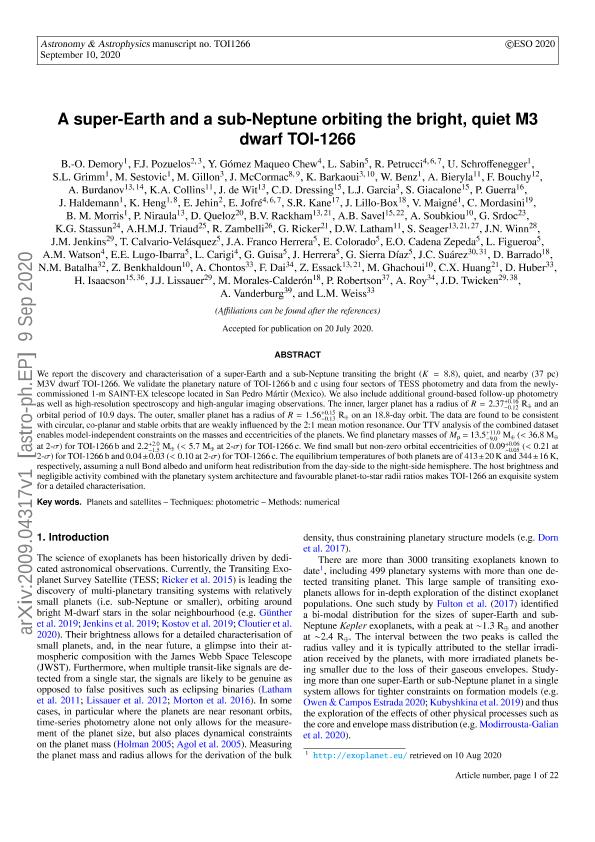Artículo
A super-Earth and a sub-Neptune orbiting the bright, quiet M3 dwarf TOI-1266
Demory, Brice Olivier; Pozuelos, F. J.; Gómez Maqueo Chew, Y.; Sabin, L.; Petrucci, Romina Paola ; Schroffenegger, U.; Grimm, S. L.; Sestovic, M.; Gillon, M.; McCormac, J.; Barkaoui, K.; Benz, W.; Bieryla, A.; Bouchy, F.; Burdanov, A.; Collins, K. A.; De Wit, J.; Dressing, C. D.; García, L. J.; Giacalone, S.; Guerra, P.; Haldemann, J.; Heng, K.; Jehin, E.; Jofré, E.; Kane, S. R.; Lillo Box, J.; Maigné, V.; Mordasini, C.; Morris, B. M.
; Schroffenegger, U.; Grimm, S. L.; Sestovic, M.; Gillon, M.; McCormac, J.; Barkaoui, K.; Benz, W.; Bieryla, A.; Bouchy, F.; Burdanov, A.; Collins, K. A.; De Wit, J.; Dressing, C. D.; García, L. J.; Giacalone, S.; Guerra, P.; Haldemann, J.; Heng, K.; Jehin, E.; Jofré, E.; Kane, S. R.; Lillo Box, J.; Maigné, V.; Mordasini, C.; Morris, B. M.
 ; Schroffenegger, U.; Grimm, S. L.; Sestovic, M.; Gillon, M.; McCormac, J.; Barkaoui, K.; Benz, W.; Bieryla, A.; Bouchy, F.; Burdanov, A.; Collins, K. A.; De Wit, J.; Dressing, C. D.; García, L. J.; Giacalone, S.; Guerra, P.; Haldemann, J.; Heng, K.; Jehin, E.; Jofré, E.; Kane, S. R.; Lillo Box, J.; Maigné, V.; Mordasini, C.; Morris, B. M.
; Schroffenegger, U.; Grimm, S. L.; Sestovic, M.; Gillon, M.; McCormac, J.; Barkaoui, K.; Benz, W.; Bieryla, A.; Bouchy, F.; Burdanov, A.; Collins, K. A.; De Wit, J.; Dressing, C. D.; García, L. J.; Giacalone, S.; Guerra, P.; Haldemann, J.; Heng, K.; Jehin, E.; Jofré, E.; Kane, S. R.; Lillo Box, J.; Maigné, V.; Mordasini, C.; Morris, B. M.
Fecha de publicación:
10/2020
Editorial:
EDP Sciences
Revista:
Astronomy and Astrophysics
ISSN:
0004-6361
Idioma:
Inglés
Tipo de recurso:
Artículo publicado
Clasificación temática:
Resumen
We report the discovery and characterisation of a super-Earth and a sub-Neptune transiting the bright (K = 8.8), quiet, and nearby (37 pc) M3V dwarf TOI-1266. We validate the planetary nature of TOI-1266 b and c using four sectors of TESS photometry and data from the newly-commissioned 1-m SAINT-EX telescope located in San Pedro Mártir (México). We also include additional ground-based follow-up photometry as well as high-resolution spectroscopy and high-angular imaging observations. The inner, larger planet has a radius of R = 2.37-0.12+0.16 R and an orbital period of 10.9 days. The outer, smaller planet has a radius of R = 1.56-0.13+0.15 R on an 18.8-day orbit. The data are found to be consistent with circular, co-planar and stable orbits that are weakly influenced by the 2:1 mean motion resonance. Our TTV analysis of the combined dataset enables model-independent constraints on the masses and eccentricities of the planets. We find planetary masses of Mp = 13.5-9.0+11.0 M (<36.8 M at 2-σ) for TOI-1266 b and 2.2-1.5+2.0 M (<5.7 M at 2-σ) for TOI-1266 c. We find small but non-zero orbital eccentricities of 0.09-0.05+0.06 (<0.21 at 2-σ) for TOI-1266 b and 0.04 ± 0.03 (< 0.10 at 2-σ) for TOI-1266 c. The equilibrium temperatures of both planets are of 413 ± 20 and 344 ± 16 K, respectively, assuming a null Bond albedo and uniform heat redistribution from the day-side to the night-side hemisphere. The host brightness and negligible activity combined with the planetary system architecture and favourable planet-to-star radii ratios makes TOI-1266 an exquisite system for a detailed characterisation.
Archivos asociados
Licencia
Identificadores
Colecciones
Articulos(CCT - CORDOBA)
Articulos de CTRO.CIENTIFICO TECNOL.CONICET - CORDOBA
Articulos de CTRO.CIENTIFICO TECNOL.CONICET - CORDOBA
Citación
Demory, Brice Olivier; Pozuelos, F. J.; Gómez Maqueo Chew, Y.; Sabin, L.; Petrucci, Romina Paola; et al.; A super-Earth and a sub-Neptune orbiting the bright, quiet M3 dwarf TOI-1266; EDP Sciences; Astronomy and Astrophysics; 642; 10-2020; 1-22
Compartir
Altmétricas



